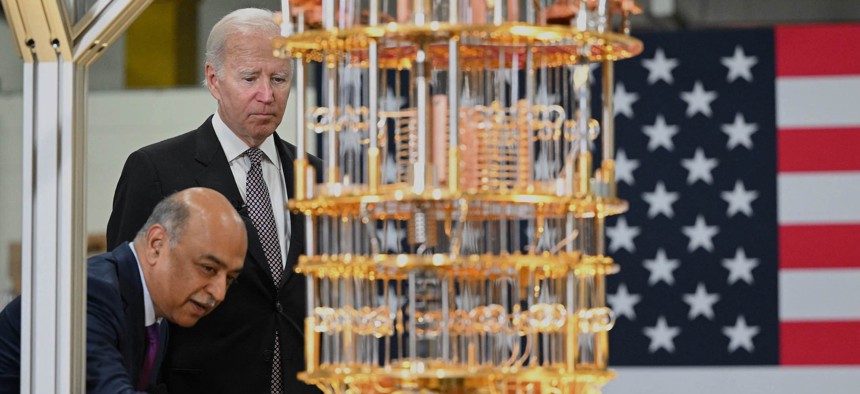DOD offices see post-quantum cryptography as 'mission critical'

President Biden examines an IBM quantum computer during a tour of a company facility in Poughkeepsie, New York in Oct. 2022. Mandel Ngan/AFP via Getty Images
Offices within the Navy and Air Force are looking to both protect systems and harness benefits of quantum information sciences and computing
Officials at the Department of Defense shed light on their agency’s plans to modernize their encryption infrastructure ahead of the anticipated advent of a fault-tolerant quantum computer, discussing familiar policy goals like private sector collaboration and supporting warfighter operations moving into 2024.
Wanda Jones-Heath, the principal cyber advisor at the U.S. Air Force said that updating the department’s encryption from classical cryptographic schemes to a network armed with post-quantum cryptographic standards. She said that this migration is “mission imperative” for the Air Force to ensure its cybersecurity defenses can handle emerging threats.
“If we had not started this two years ago, we would be even further behind,” she said in remarks on a panel on Tuesday hosted by General Dynamics Information Technology. “Now we are again [in] a sense of urgency...this is a national security issue.”
Continued department-wide investments in transitioning both the hardware and software for classical computing will be critical to successfully migrate in the months and years ahead.
Dan Gunlycke, the Navy’s lead for quantum computing at the Naval Research Laboratory, said that his organization is preparing and fortifying networks against quantum computers, while looking to harness the emerging technology’s potential benefits.
Some of the research focus areas he listed beyond cryptography include quantum simulation and leveraging these simulations for fluid dynamics challenges.
“A lot of the algorithmic tools that you develop in one application area [are] transferable to another so we have set up a roadmap of different application areas that we are looking at,” he said. This includes the establishment of a new Naval Quantum Computing Programming Office.
Gunlycke added that some of the applications his office is researching involve helping warfighters predict adversarial decisions through quantum computer-powered risk and probability assessments.
“When we want to make risk assessments we need to have a very good understanding of the different probabilities of different outcomes,” he said.
Success for both the Navy and Air Force’s quantum information research and application is partially contingent on partnerships, both between other government agencies and private sector companies.
“I'm excited to see what comes out in the next year when we get those algorithms in figuring out, you know, our roadmap to making sure that we're able to transition effectively,” Jones-Heath said.
A report from the Government Accountability Office released on Tuesday noted that, "nations that lead in quantum technologies can gain a competitive edge in areas such as cryptography, sensing, and computing." The report tallied up efforts across four defense labs and found that 255 staffers, mostly physicists and engineers at the PhD level, were working on quantum computing projects in fiscal year 2023.






